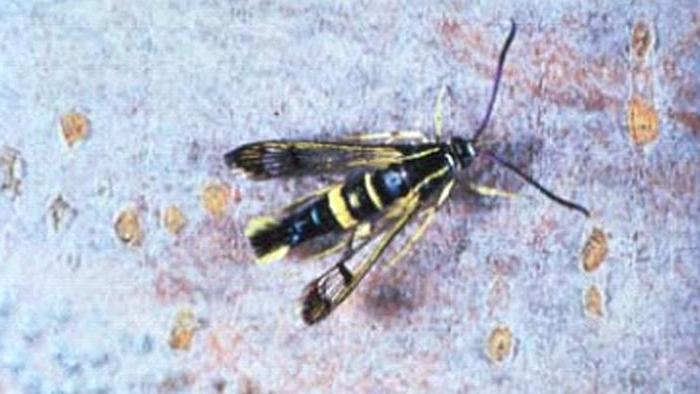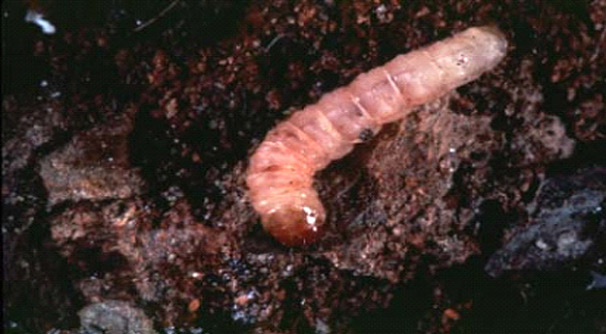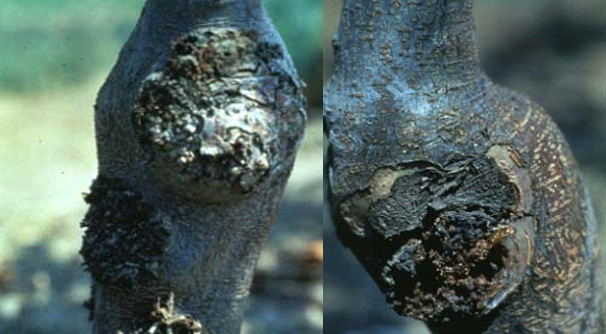Horticultural Pest and Disease Board
Dogwood Borer

Dogwood Borer
Tree Fruit IPM Insect Identification Sheet No. 14
Synanthedon scitula (Harris)
Introduction
The dogwood borer (DWB), a native clearwing moth, can be found from southeastern Canada to Florida, and as far west as the Mississippi. The insect has a wide host range including dogwood, pecan, oak, plum, and apple. The DWB has one generation per year throughout its geographic distribution. On apple, DWB larvae feed primarily in burrknot tissue on clonal rootstocks. Burrknots are aggregations of root initials which can develop on the above ground portion of the rootstock. All commercial dwarfing and semi-dwarfing rootstocks have a tendency to develop burrknots.
The Adults
The DWB adult has a wing span of 18-22 mm. Both the fore and hind wings are mostly clear. The thorax and abdomen are deep blue-black with yellow markings. In the female, the entire 4th abdominal segment is yellow , while in the male it is black with a narrow yellow ring. In the Northeast, adult emergence begins in early June and continues into early September, peaking in mid July. Emergence begins earlier further south.
The Eggs
The eggs are light chestnut brown, oval, 0.6 by 0.4 mm, and are marked with a hexagonal pattern of slightly raised lines. Eggs are laid singly on the trunk, and hatch after an incubation period of 8-9 days.
The Larvae

The larvae are off-white to cream colored with a reddish head capsule. Larvae pass through six instars ranging in length from 1 mm when newly hatched to 15 mm or more in the last instar. Soon after hatching, the larvae begin to burrow into the soft burrknot tissue, or areas under bark scales. As the larvae feed, reddish-brown frass is pushed to the surface, where it collects, held together by silk (Fig. 5). Larvae overwinter in the feeding tunnel. Feeding resumes whenever the temperature is above 45-50 F (7-10 C).
Larvae of the American plum borer (APB), Euzophera semifuneralis (Walker), have been found on apple in habitats similar to those preferred by the dogwood borer. The larvae of the two species are similar in size. However, the DWB larva is white to cream-colored, and has only one row of crochets on the abdominal prolegs, while the APB larva is dusky purple to gray in color, and has two rows of crochets on the prolegs.
The Pupae
Pupation occurs in the feeding tunnel in a tough silken cocoon covered with bits of frass. The length of the pupal stage is variable, lasting from 8-20 days, depending on the temperature. Prior to emergence, the pupa pushes out of the cocoon and to the surface of the burrknot. The amber-colored pupal case often remains on the burrknot after the adult emerges.
Damage

Three general feeding types have been identified for the DWB on clonal apple rootstocks. Most frequently, feeding is confined to the burrknot (Type I). One or more larvae feed in irregular tunnels beneath the surface of the root initials. At first, feeding is quite shallow, but subsequent feeding may extend as far as 3/4-inch toward the center of the trunk. Feeding confined to the burrknot is believed to be least harmful to the tree.
The second type of feeding may occur as a result of heavy or repeated infestation of a burrknot. As the burrknot tissue is consumed, the larvae move outward and begin to feed on the cambium adjacent to the burrknot (Type II). The third feeding type is not associated with a burrknot, but with bark scales and injured bark, and occurs infrequently (Type III). Feeding outside the burrknot is thought to be more harmful to the tree because healthy cambium tissue is destroyed. DWB infestations can girdle and kill a tree, but more commonly contribute to a slow decline and yield reduction if they continue over a long period of time.
Control
The best method of preventing DWB infestations on clonal rootstocks is to avoid burrknot development. Unfortunately, rootstocks without an inherent tendency to develop burrknots are not yet available. Burrknots found in the orchard were initiated in the stoolbed or the nursery, and their expression is influenced by environmental and cultural conditions in the orchard. Some agricultural chemicals with hormonal effects, such as naphthalene acetic acid, can increase the expression of burrknots. Roots will develop from burrknots if new plantings are set with the graft union close to ground level. In established plantings where the graft union is not too high above the ground, a wide cone of soil can be mounded around the exposed portion of the rootstock to accomplish the same purpose. The cone of soil must be wide enough to prevent freezing injury to the buried rootstock. Where it is not possible to bury exposed rootstocks, the area around the trunk should be kept weed free to avoid shade and high humidity. Both of these conditions favor growth and development of burrknots initiated in the nursery.
Several parasitoids and a fungal pathogen have been reported attacking the dogwood borer, but none provide appreciable control. White latex paint brushed on the exposed portion of the rootstock before egg laying begins will prevent new infestations, and also protect against south-west injury to the bark. Dilute trunk applications of an insecticide with good residual activity can provide control of established infestations. Consult local recommendations for the best materials and timing in your area.
Guide To Stages
|
Stage |
Timing |
Where to look |
|
Adults |
June through August |
Not commonly seen. May linger on trunk immediately after emergence. |
|
Eggs |
June through August |
On burrknots and on bark surface near cracks. Very difficult to see. |
|
Larvae |
Throughout the year |
Tunnelling beneath surface of burrknot tissue or bark. |
Credits
Authors: A. Seaman, H. Riedl, and J. Cummins.
Photographs by J. Ogrodnick and H. Riedl.
Published by the New York State Agricultural Experiment Station, Geneva, A division of the New York State College of Agriculture and Life Sciences, A Statutory College of the State University, Cornell University, Ithaca, NY.
Posted: 01/02/2015 10:20 AM
Last Updated: 01/07/2015 12:12 PM